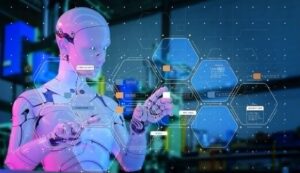AI climate
AI climate: The risks and opportunities present by AI
As someone deeply invested in both technology and environmental sustainability, I find the intersection of Artificial Intelligence (AI) and climate change fascinating and full of potential. AI has become an essential tool in a wide range of industries, but when it comes to tackling climate change, its applications could be game-changing.
From optimising renewable energy sources to providing accurate climate predictions, AI holds the promise of driving the transformation we need to combat the climate crisis. However, like any powerful tool, AI also brings its own set of risks—chief among them being its environmental impact and unintended consequences.
In this blog post, I’ll explore both the risks and the opportunities presented by AI in the fight against climate change. By diving into these aspects, I hope to provide a balanced view of how AI can be harnessed responsibly to make a real difference for the planet.
AI Climate: A Brief Overview
The term “AI climate” refers to the intersection of artificial intelligence and climate action. AI’s role in climate science includes everything from optimising renewable energy systems to providing accurate climate models, which help scientists and policymakers make data-driven decisions.
However, the very use of AI brings with it an environmental footprint, as running large AI models can consume significant energy and resources. It’s essential to understand both the potential benefits and drawbacks of AI in the context of climate change to harness its power responsibly.
5 Risks AI Poses to Climate Change Mitigation
While AI holds promise in the fight against climate change, it comes with its own set of challenges:
Energy Consumption
Training complex AI models requires significant computational power, which in turn consumes substantial amounts of energy. According to research, large language models can generate carbon emissions equivalent to those of several cars driven over a year. As AI continues to scale, finding ways to offset or minimise this energy impact will be essential. Platforms like Green AI aim to make AI development more sustainable.Carbon Footprint of AI Training
The carbon footprint of training large AI models can be considerable. For example, developing advanced models often involves using energy-intensive data centres, which contribute to greenhouse gas emissions unless powered by renewable sources. To manage this, tech companies are increasingly investing in green data centres powered by solar or wind energy.Resource Scarcity
Many AI technologies rely on rare minerals such as lithium and cobalt, essential for the batteries and components in AI hardware. This reliance on limited resources raises concerns about resource depletion and environmental degradation associated with mining.Data Privacy Concerns in Environmental Monitoring
AI-powered monitoring systems, especially those using satellite and IoT (Internet of Things) data, often gather sensitive information that can raise privacy issues. Balancing effective environmental monitoring with data privacy rights remains a challenge.Unintended Environmental Consequences
Some AI applications, designed with good intentions, may have unforeseen impacts on the environment. For example, AI models used to enhance agricultural yield could lead to over-reliance on specific crops, potentially reducing biodiversity. Ensuring that AI applications are designed with environmental safeguards in mind is crucial.
5 Key Opportunities AI Provides in Fighting Climate Change
Despite these risks, AI also holds immense potential to contribute positively to climate change mitigation. Here are five opportunities where AI can make a real impact:
Enhanced Climate Modelling
AI enables scientists to develop highly accurate climate models that predict future climate scenarios. By analysing vast datasets, AI can identify trends and provide insights that help in understanding climate changes and extreme weather patterns. For instance, tools like ClimateAi offer climate risk intelligence that helps organisations adapt to climate impacts.Optimisation of Renewable Energy Sources
AI can play a vital role in optimising the management and distribution of renewable energy sources such as wind, solar, and hydroelectric power. By analysing weather data, AI systems can forecast energy production and improve grid efficiency, ensuring a stable and reliable renewable energy supply.Precision Agriculture
AI-powered precision agriculture uses sensors, drones, and AI algorithms to optimise water, fertiliser, and pesticide use. By helping farmers make data-driven decisions, AI not only enhances crop yield but also reduces waste, which is crucial in the face of water scarcity and soil depletion.Real-Time Emission Tracking
With AI-powered emission tracking, companies and governments can monitor greenhouse gas emissions in real time. This transparency allows for better regulatory compliance and targeted climate action. Tools like Carbon Tracker use AI to track emissions and provide insights into the financial risks associated with fossil fuels.Carbon Capture and Storage Management
AI can be instrumental in enhancing the effectiveness of carbon capture and storage (CCS) technologies by optimising storage facilities and monitoring captured carbon levels. Companies like Carbon Clean use AI to advance carbon capture solutions, making them more viable in reducing atmospheric CO2 levels.
7 Practical Ways AI is Addressing Climate Change Today
AI is already at the forefront of innovative solutions for climate action. Here are seven practical ways AI is making a difference in the fight against climate change:
Satellite Imagery Analysis for Deforestation
AI-powered satellite image analysis detects illegal logging and deforestation, enabling governments and NGOs to intervene promptly. Platforms like Global Forest Watch provide real-time data on forest cover changes.Smart Grids for Energy Distribution
AI is helping develop smart grids that can manage electricity distribution more efficiently, reducing energy waste. These grids adjust power distribution based on demand, thus conserving energy.Predictive Analytics for Disaster Management
AI can forecast natural disasters like hurricanes and floods, enabling better preparation and response. The UN’s Global Disaster Alert and Coordination System uses AI for rapid alerts on disaster events worldwide.Monitoring Ocean Health
AI applications are being used to monitor oceanic pollution levels, track marine biodiversity, and provide insights into ocean health, which is essential for addressing marine ecosystem challenges.AI-Driven Public Transportation Optimisation
AI-driven algorithms optimise public transportation systems, making them more efficient and reducing urban carbon emissions. Cities like London and Singapore have started using AI to improve public transit routes and schedules.Sustainable Urban Planning Tools
AI can support urban planners by analysing environmental data to design sustainable cities. Tools like UrbanFootprint help planners visualise and mitigate the environmental impact of urban development.Wildlife Tracking and Conservation
AI-powered monitoring systems are helping conservationists track endangered species, combat poaching, and protect biodiversity. The Wildlife Conservation Society uses AI to identify and track wildlife populations.
Finally
Looking at the broader picture, it’s clear to me that AI has the potential to play a pivotal role in addressing climate change—but only if we approach it with caution and responsibility.
While AI offers remarkable opportunities to optimise energy systems, reduce emissions, and monitor environmental changes, its development and deployment must be carefully managed to mitigate its environmental impact.
As we move forward, it’s important to strike the right balance between innovation and sustainability. I believe that by using AI thoughtfully and ethically, we can unlock its full potential in combating climate change, ultimately helping to create a more sustainable world for future generations.
Let’s embrace this technology, but let’s also ensure it works for the planet and not against it.
Useful Resources
- World Economic Forum Article on AI Combating Climate Change
- Carbon Tracker – AI-powered Emissions Monitoring
- ClimateAi – Climate Risk Intelligence
FAQs
Q: Can AI really help reduce global warming?
A: Yes, AI enables accurate climate models, optimises renewable energy, and contributes to sustainable practices in sectors like agriculture and urban planning.Q: What are the main challenges with AI and climate change?
A: Key challenges include the high energy consumption of AI models, resource scarcity, and potential unintended environmental impacts.Q: How can AI reduce carbon footprints?
A: By optimising resource use, monitoring emissions, and improving efficiency in industries such as energy and transportation.Q: What are some ethical concerns related to AI and climate action?
A: Issues include data privacy, resource extraction for hardware, and the risk of unanticipated consequences in ecosystems.Q: How can individuals support AI’s role in combating climate change?
A: By advocating for sustainable AI development, supporting eco-friendly AI initiatives, and staying informed on AI’s impact on the environment.


















